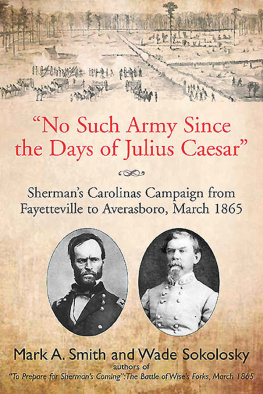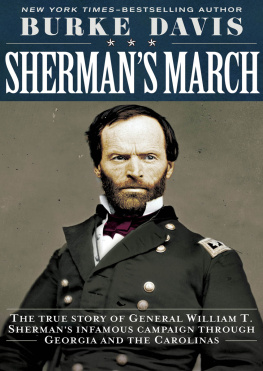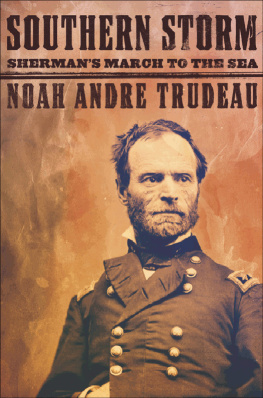O N
S HERMANS
T RAIL
O N
S HERMANS
T RAIL
The Civil Wars
North Carolina
Climax
Jim Wise

Published by The History Press
Charleston, SC 29403
www.historypress.net
Copyright 2008 by Jim Wise
All rights reserved
Cover design by Marshall Hudson.
Unless otherwise noted, photos are by the author.
First published 2008
Second printing 2010
e-book edition 2011
ISBN 978.1.61423.036.6
Library of Congress Cataloging-in-Publication Data
Wise, James E., 1949
On Shermans trail : the Civil Wars North Carolina climax / Jim Wise.
p. cm.
Includes bibliographical references.
print edition: ISBN-13: 978-1-59629-357-1 (alk. paper)
1. Shermans March through the Carolinas. 2. North
Carolina--History--Civil War, 1861-1865--Campaigns. 3. Sherman, William T.
(William Tecumseh), 1820-1891. 4. United States--History--Civil War,
1861-1865--Campaigns. I. Title.
E477.7.W57 2008
973.7378--dc22
2007046945.
Notice: The information in this book is true and complete to the best of our knowledge. It is offered without guarantee on the part of the author or The History Press. The author and The History Press disclaim all liability in connection with the use of this book.
All rights reserved. No part of this book may be reproduced or transmitted in any form whatsoever without prior written permission from the publisher except in the case of brief quotations embodied in critical articles and reviews.
For Aunts Blannie and Eleanor.
Now sainted, never Reconstructed.
Contents
Preface
As best an aging brain recalls, my introduction to William Tecumseh Sherman came at around age three or four, in Wink Vaughns filling station in Madison, Georgia, when one of my Dads fishing buddies pointed outside and told me, General Shermans army marched right down that street right there.
Not sure just what General Sherman was, and imagining his march as a procession of (Sherman?) tanks, I filed away the information and my formative years impressions of the War Between the States (Nothing civil about it, I was told) came from Robert E. Lee biographies (I had a proper Southern upbringing), Fess Parker and Disneys Great Locomotive Chase movie and The Gray Ghost TV series. At a little later age, there was seeing and reading Gone With the Wind during the Civil War Centennial.
And still later, as a Duke University undergraduate in Durham, North Carolina, I made acquaintance of Bennett Placenot yet, in the 1960s, a state historic site but just a quiet park inside a stone wall, with a couple of old cabins and a monument to Unity. It was a good place to go and toss a football aroundyoud always have the place to yourself.
And there was putting on a professional Southerner persona in the presence of collegiate Yankees; a couple of visits to Gettysburg, the second of which permanently alienated our children (then six and four) from battlefield tourism; and the realization that my adopted hometown of Durham owed its prosperity, if not its very existence, to the Civil Wars coincidental resolution there.
Still, any sense was a long time coming of how Chickamauga connected with Shiloh with Second Manassas with Fort Sumter with so on with so forth with me. So I trace the genesis of this volume to a hot morning in July 1995, standing on Stagecoach Road in southern Durham at a one-lane bridge over swampy New Hope Creek, and hearing Ernie Dollar tell me, Right here was the last huzzah.
That last huzzah was the last firefight of the Civil War in North Carolinathere, right down there. So first on my roster of acknowledgements and thanks comes Erniereenactor, artist, historian and presently head of the Preservation Society of Chapel Hill.
Over the years of being a folklore graduate student under the inimitable Daniel W. Patterson and Charles G. Zug at the University of North Carolina; a hometown journalist with several employers; and, most of all, teaching local and Southern history (with the attendant obligation to know what Im talking about) at my undergraduate alma maters Osher Lifelong Learning Institute (ne Duke Institute for Learning in Retirement), Ive absorbed some notions of the past and the process of history making, and acquired others by deliberate research and brooding. Thanks particularly to Sara Craven and Florence Blakeley, DILR former director and volunteer.
Much appreciation also for the mentoring of Durham architects and history appreciators George Pyne and Frank DePasquale, and members of the staffs and friends of Bennett Place, Duke Homestead and Stagville historic sites and West Point on the Eno and Leigh Farm city parks; and for the underappreciated but outstanding librarians John Ainslie and Lynn Richardson and the North Carolina Collection at the Durham Public Librarywhich happened to have a wealth of primary source material in original editions on which I have relied for this book.
Thanks also to Gordon Clapp, the New England transplant who founded the North Carolina Civil War Tourism Council in 1994; John Dunlap of the Anson County Historical Society; the Reverend Dr. Howard H. Whitehurst of Laurel Hill Presbyterian Church; Julie Ganis of the outstanding Union and Anson County Civil War Websites; and Kim Cumber of the North Carolina State Archives, for advice, information and invaluable assistance along the way.
As always, greatest appreciation and love for my wife, Babs, the eternally encouraging and patient.
In this book, I have tried to point out the layering of pasts in our landscapefor Shermans soldiers, the Confederates who resisted them and the civilians who survived thempassed through, and lived in, territories already rich with associations from earlier times and in many cases earlier wars. The town of Sneedsboro (also known as Sneydsboro) for example, which was established by real estate speculators in the eighteenth century, was already abandoned by the time Civil War soldiers came to cross the Pee Dee River there. Also notable are sites that were important in the Revolution and those with connections to the War of 1812 and even with Bonnie Prince Charlie and the Highland rising of 1745 and its conclusion at Culloden.
There are also the pasts overlaid since 1865the coming and going of tobacco culture, for example; the movements of populations and whole towns as railroads and new highways came; the continuing succession of New Souths; and continuing revisions and reinventions of just what happened, and to whom, and why, between April 1861 and April 1865.
This volume begins with General Sherman at one climactic point in North Carolina, flashes back to bring him there and finishes with his last weeks in the state when events in Virginia put the wars resolution in North Carolina and elsewhere squarely into his hands. It closes with Joseph Johnstons surrender to Sherman at the Bennett farm near Durhams Station. To the extent practical, I have tried to let those who were there narrate and comment on these matters, though as their editor here the choices, arrangement and blame are mineincluding the decision to leave spellings, capitalizations and other matters of style as the writers had them.
Sherman left North Carolina a changed state, but almost 175 years since his passage have left it transformed. Open fields have turned back to woods and woods to shopping centers. Elizabeth Allstons two-room houses have been replaced by brick ranch styles and double-wide mobile homes. The dirt wagon roads turned muddy sloughs through which the armies trudged have hard surfaces now, and run straighter, if they are still in use at all. The railroads are still here, but they now have multilane highways and oversized trucks to compete with.
Next page





